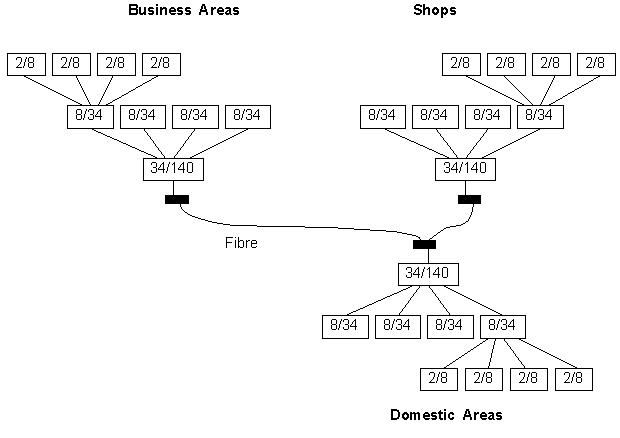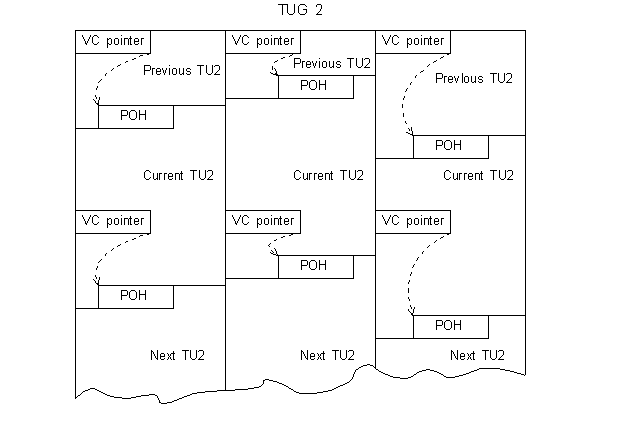Synchronous Digital Hierarchy (SDH)
Introduction
The Transmission System is traditionally seen as the link between main WAN switching centres.
These Transmission Systems consist of large bandwidth highways that form the backbone to the network.
They typically serve many customers each with their own requirements so the systems have to be
reliable, resilient and flexible.
Rather than have two wires for every voice or data conversation, Time Division Multiplexing is used. ITU-T G.704 defines 32
channels of 64Kb/s to form 2.048Mb/s where channel 0 is used for framing.
You will often see the standard G.703 mentioned with G.704, this is because G.703 defines the unframed
physical interface coaxial (75 ohm) or RJ48 (120 ohm) used for the E1/T1 connection at the client premises.
Channel 0 is for timing used to synchronise
the multiplexers at each end of the link. Channels 1 to 15 and 17 to 31 are for voice or data whilst
channel 16 is used for Common Channel Signalling (CCS) or
Channel Associated Signalling (CAS). Every 3.91 microseconds
8 bits from one channel is sent down the line followed by 8 bits from the next channel during the next
3.91 microseconds and so on in a round robin fashion throughout all the channels, thus 32 channels are used
once every 125 microseconds.
The connection at the end is either a 75 ohm coax, 120 ohm coax or a 150 ohm UTP/STP.
Plesiochronous Digital Hierarchy (PDH)
As bandwidth demand grew the technology called Plesiochronous Digital Hierarchy (PDH) was developed by ITU-T G.702,
whereby the basic primary multiplexer 2.048Mb/s trunks were joined together by adding bits
(bit stuffing) which synchronised the trunks at each level of the PDH. 2.048Mb/s was called
E1 and the hierarchy is based on multiples of 4 E1s.
- E2, 4 x E1 - 8Mb/s
- E3, 4 x E2 - 34Mb/s
- E4, 4 x E3 - 140Mb/s
- E5, 4 x E4 - 565Mb/s
The E3 tributaries are faster than the E2 tributaries, E2 tributaries are faster than the E1 tributaries and so on.
These need to be synchronised with other tributaries, so extra bits are added called Justification bits.
These tell the multiplexers which bits are data and which are spare. Multiplexers on the same level
of the hierarchy remove the spare bits and are synchronised with each other at that level only.
Multiplexers on one level operate on a different timing from multiplxers on another level. For instance, the
timing between Primary Rate Muxes (combines 30 x 64Kb/s channels into 2.048Mb/s E1)
will be different from the timing between 8Mbit muxes (combines up to 4 x 2Mb/s into 8Mb/s).

Inserting and dropping out traffic from different customers can only happen at the level
at which the customer is receiving the traffic. This means that if a 140Mb/s fibre is
near a particular site and a new customer requires a 2Mb/s link, then a whole set of demultiplexers are required to do this.
Synchronous Digital Hierarchy (SDH)
Management is very inflexible in PDH, so SDH was developed. Synchronous Digital Hierarchy (SDH) originates from Synchronous Optical
Network (SONET) in the US. It includes capabilities for bandwidth on demand and is also made
up of multiples of E1. STM-1 (155Mb/s) is 63 x E1, STM-4 (622Mb/s) is 4 x STM-1 and STM-16 (2.5Gb/s) is 4 x STM-4.
The benefits of SDH are:
- Different interfaces or different bandwidths can connect (G708, G781).
- Network topologies are more flexible.
- There is flexibility for growth.
- The optical interface is standard (G957).
- Network Management is easier to perform (G774 and G784).
Existing PDH can interface into SDH. There are three G transmission series recommendations that are very important:
- G.707 - SDH Bit Rates
- G.708 - The SDH Network Node Interface.
- G.709 - Synchronous Multiplexing structure.

With the exception of 8Mb/s, different PDH outputs are 'mapped' into Containers (C) and then
into fixed size Virtual Containers (VC). When the VC is aligned in the Tributary Unit (TU)
a Pointer is added which indicates the phase of the particular VC. TU's are then grouped,
via Time Division Multiplexing (TDM), into Tributary Unit Groups (TUG).
The TUGs are collated into Administrative Units (AU) via more VCs where more pointers are added (these
being fixed relative to the frame). The VCs and the pointers are incorporated into the section overhead
of the Synchronous Transport Module (STM). One AU forms an STM-1, 4 AUs form an STM-4. You can also get STM-16 and STM-64.
Let us follow a 2Mb/s pipe through the hierarchy.
The 2Mb/s PDH first enters a container C12 which compensates for the varying speeds via the use of stuff bits (R).
Stuff opportunities are identified by S1 and S2 and these are controlled by the control bits C1 and C2
respectively. If the C bits are are 0s then the corresponding S bits contain data and if the C bits are 1s then the S bits
are not defined. In the diagram below, O represents Overhead channel bits and I represents Information bits.

To create the VC12 a Path Overhead (POH) is added. The POH uses Bit Interleaved Parity (BIP) to monitor errors.
In addition, there are fault indicators, Far End Block Error (FEBE), Remote Fail Indicator (RFI) and
Far End Receive Failure (FERF). The Signal Label is normally set at 2 to indicate asynchronous data.
A pointer is added to the VC12 which defines the phase alignment of the VC12 and this changes during
transmission. Phase variation can be due to Jitter (from regeneration and multiplexing
equipment) and Wander (temperature differences within the transmission media).
VC12s created by different multiplexers may not be synchronous so the TU adds a pointer at
a fixed position within the TU. The value of the pointer indicates the start of the VC12.
If the phase of the VC12 changes then the value of the pointer changes such that if data
is running faster than the TU then the pointer value is increased and if the data speed is slower
then the pointer value is decreased. This difference in speed can be up to one byte per frame
in SDH.
The following diagram illustrates three TU12s entering a TUG2 at three different times with the VC12 pointers indicating where the
POH is for each:

The TU12 is multiplexed into a TUG 2 along with 2 other TU12s. This is achieved by interleving the bytes of each TU12 in turn.
Next, seven TUG 2s are byte interleaved into a TUG 3 and then three TUG 3s can be byte interleaved to form the VC4 (see the SDH
diagram above). You can see that 3 x 7 x 3 = 63 2Mb/s circuits can be contained in VC 4.

|

